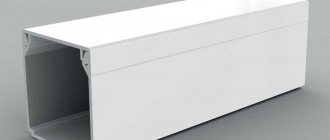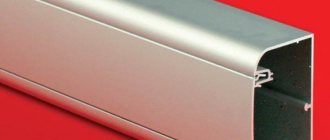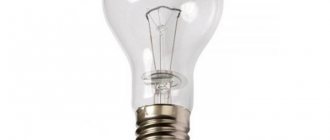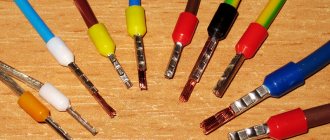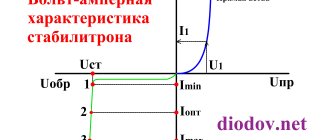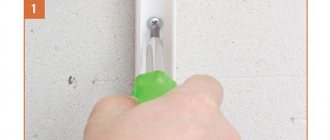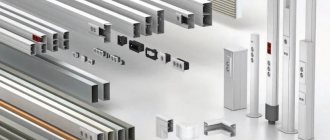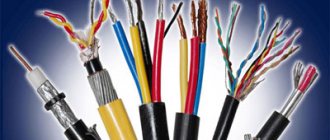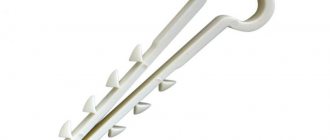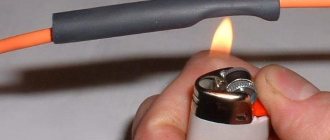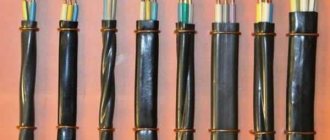Electrician in the house
Encyclopedia about electricity from A to Z
Masters catalog
Find the best master or company in your city
Metal boxes
The metal box for wires has found quite wide application in electrical engineering. It is used to protect cable and wire products from mechanical, chemical and other types of damage.
Such a box has a fairly attractive appearance and, most importantly, in some cases it is simply not replaceable.
- Types of metal boxes
- The use of metal boxes The use of metal boxes for hidden wiring
- The use of metal boxes for open wiring
Plastic cable channels, their types and sizes
Most often, plastic types of cable channels are used for laying information cables in offices and, if necessary, to make open or temporary wiring - in this case, power cables and wires for lighting lines are also laid in them.
Shape, materials and dimensions
Initially, these were white or gray profiles, rectangular in cross-section in the shape of the letter “P” (single-section) or “W” (two or more sections). Then they began to produce cable channels of various shapes and colors, intended for laying cables for various purposes.
Triangular cable channels or in the shape of a hemisphere appeared - it became more convenient to use them for wires for various purposes, depending on the purpose of the room, the materials used in its decoration and the need for free access to the cables hidden inside.
U-shaped cable channel.
Triangular cable channel.
Sh-shaped cable channel.
Cable channel in the form of a hemisphere.
For the production of cable channels, non-flammable PVC or polyethylene is used. The length of one section is usually 2 meters, but manufacturers may use other standards, so longer cable channels can be found if necessary. The cross-sectional width and height range from 10 to 60 mm, but there may be exceptions here.
The most popular are U-shaped cable channels. U-shaped cable channels can be made with solid or perforated walls. Their advantages include lower weight and lower price.
Dimensions of U-shaped cable channels and their useful cross-section:
| Profile | Size (width × height), mm | Useful cross-section, mm2 | Wall thickness, mm |
| 12x12 | 130 | 1 | |
| 15x10 | 135 | 1 | |
| 16x16 | 230 | 1 | |
| 20x10 | 180 | 1 | |
| 25x16 | 360 | 1,1 | |
| 25x25 | 563 | 1,1 | |
| 40x16 | 576 | 1,3 | |
| 40x25 | 900 | 1,3 | |
| 40x40 | 1440 | 1,3 | |
| 60x40 | 2160 | 1,7 | |
| 60x60 | 3240 | 1,7 | |
| 80x40 | 2880 | 1,7 | |
| 80x60 | 4320 | 1,7 | |
| 100x40 | 3600 | 2 | |
| 100x60 | 5400 | 2 |
*The useful cross-section of cable channels from some manufacturers may differ from that shown in the table.
Surface attachment method
Depending on the material of the surface on which the cable channel needs to be secured, collapsible and non-removable fasteners are used. The first include dowel-nails (6Ch40), metal staples or self-tapping screws - for them, holes are cut in some cable channels from the factory. Permanent fasteners are used on plasters and similar materials - cable channels are simply glued to them (although here the weight of the box with wires must be taken into account).
Additional items
To avoid having to manually cut boxes for turns or branches of the highway, manufacturers produce additional elements - turning corners, tees, plugs, etc. for each type of cable channels. They allow you to create wiring of any complexity without damaging the interior or wasting time on installation.
There are also separate fastenings for sockets and switches - these elements of the electrical circuit are mounted in special elements that are fixed directly into the cable channel.
Floor and baseboard cable channels
Floor and baseboard cable ducts are a separate category.
Floor cable channels.
All floor and plinth cable channels also have their own additional elements that simplify the laying of highways.
Plinth cable channels are hollow inside and can accommodate many wires. This is an excellent option for laying antenna or computer cables.
+ Pros of cable channels
- There is no need to groove walls to lay wires.
- The laid cable is always open for inspection - you can always lay an additional line nearby.
- Despite its apparent softness, the cable channel additionally protects the wires laid in it from mechanical damage.
- The installation of the main line is carried out as quickly as possible.
- Various forms of cable channels allow you to fit the external electrical wiring line into most interior solutions.
— Cons of cable channels
- Sometimes cable channels do not look at all in the interior of the room.
- The box “takes away” several centimeters of space from the wall.
- It is easy to accidentally snag the cable channel - knock it off the fastening or break it.
- High-quality installation is only possible with the use of a large number of additional accessories - turns, branches, etc.
No. 7. How to evaluate quality when purchasing?
When purchasing, carefully inspect the selected sample. A small examination will allow you to understand how high-quality the product is:
- The plastic must be rigid enough to hold its shape properly. Cracks, dents and other deformations are not allowed;
- ideal geometry, smoothness and evenness of the ends - evidence of high quality
- The cover should be easy to install and remove. It's better to try closing and opening the lock a couple of times. If all this happens very easily, and no cracks appear on the plastic, then you have a quality product;
- evidence that the manufacturer took a responsible approach to the issue of channel production is the presence of separators, clips and ties for convenient installation of several different cables. Yes, not every high-quality channel has such bells and whistles, but their presence means that this is a really good product.
Metal boxes - types and sizes
Since metal trays and boxes are designed for heavy loads, the need to use them in domestic conditions arises quite rarely. The types and sizes of metal cable ducts are mainly suitable for external and internal laying of cables in industrial premises where there are highways consisting of a large number of wires. To prevent the material of the boxes from rusting, galvanized steel is used in their production. Like plastic ones, the cross-section of metal cable channels is U-shaped - with or without a cover.
Depending on the conditions of use, perforated, smooth and ladder trays are manufactured. The former are easier to install and secure cables inside, while the latter are heavier and are installed on special supports.
Cable tray sizes:
| Dimensions (width × height × length), mm | Metal thickness, mm | Useful cross-sectional area, cm2 |
| 50×50×2500 | 0,55 | 24,22 |
| 100×50×2500 | 0,55 | 48,44 |
| 200×50×2500 | 0,7 | 98,44 |
| 300×50×2500 | 0,7 | 147,44 |
| 400×50×2500 | 1,0 | 198,44 |
Due to their heavy weight, gluing metal boxes is not practiced - they are attached to the surface with anchors, dowels, or “mounted” on a bolted connection. To install smooth trays, shelves or brackets pre-fixed to the surface are used.
Most often, metal boxes are used to form electrical lines in raised floors or suspended ceilings. For their installation, additional blocks are used - rotating, lifting (for transferring wires between planes), branching, etc.
+ Pros of metal cable channels
- Withstands the weight of a large number of power cables.
- They allow you to easily trace the route of any cable, provide ease of installation and easy access for inspection or replacement.
- An additional plus for fire safety.
— Disadvantages of metal cable channels
- Greater weight requires more serious installation work.
- It is more difficult to process during installation (if cutting is required).
- These types of cable channels for electrical wiring necessarily require additional components for the installation of turns and transitions.
Our catalog
The online store 220.ru offers at a reasonable cost different types (types) of plastic electrical boxes in size, color, etc. The cost of the product can be seen in the price list: there is a photo and the price per meter is indicated. Here you can choose electrical boxes:
- for external (street) or internal wiring;
- wall or floor electrical installation.
To buy a product, fill out an application on the website. We sell electrical products in Moscow and other regions of the Russian Federation from trusted companies. We accept payment in cash and by bank transfer.
We also accept calls from customers to tell us about discounts and promotions. You can ask the operators on duty about the time frame for receiving the goods.
Corrugated plastic pipes
If cable channels, plastic or metal, are more suitable for flat surfaces, then in the case of frequent transitions between planes or turns, their installation will be extremely difficult due to the need to use a large number of additional components. In such conditions, a more suitable material would be flexible pipes that bend at any angle and are attached along the entire length to standard clips.
Externally, a corrugated plastic pipe looks like an elastic channel with a circular cross-section. It is used for laying any cables and wires, providing them with additional protection from moisture and mechanical damage. Mainly used when installing electrical circuits with complex wire routing paths - raised floors, suspended ceilings, electrical wiring behind plasterboard walls.
Dimensions and components
PVC is used for the production of corrugated plastic pipes. Most often, products with an internal diameter from 16 to 32 mm are used, but when choosing, you must additionally pay attention to the purpose of the corrugation - it can be light or heavy.
The first are standard products that are used for installing electrical circuit lines inside buildings. Heavy corrugations provide more solid protection and can be used outdoors, and in some cases, under water.
Since in long highways it is not always possible to push a wire through a pipe without auxiliary parts, additional corrugations can be equipped with probes made of metal single-core “steel”, however, installers usually have their own.
Dimensions of corrugated pipes for cable:
| Heading | Outer diameter, mm | Inner diameter, mm |
| Corrugated PVC pipe without probe | 16 | 10,7 |
| 20 | 14,1 | |
| 25 | 18,3 | |
| 32 | 24,3 | |
| 40 | 31,2 | |
| 50 | 39,6 | |
| 63 | 5,6 | |
| Corrugated PVC pipe with probe | 16 | 10,7 |
| 20 | 14,1 | |
| 25 | 18,3 | |
| 32 | 24,3 | |
| 40 | 31,2 | |
| 50 | 39,6 | |
| 63 | 50,6 |
+ Advantages of plastic corrugated pipes
- Indispensable for laying wires on uneven surfaces or when it is necessary to make frequent turns in the highway.
- Usually sealed along the entire length, therefore they reliably protect the wires from high humidity.
- Additional protection of cables from mechanical damage and people from electric shock.
- Clip-on mounting is one of the easiest to install and maintain - you can insert or remove the corrugation from them without additional tools.
- In addition to fire safety, the plastic from which the corrugation is made contains additives that prevent combustion. When the wiring is shorted, the corrugation will not flare up, but will simply melt.
— Disadvantages of plastic corrugated pipes
- They do not tolerate negative temperatures well - when overcooled, they lose elasticity and break, so they are more suitable for interior work.
- If there are too many turns and bends, pulling the cable inside the corrugation will be very difficult and sometimes impossible, so you will have to first pull the wires inside and then carry out the general installation.
Installation recommendations
Connection diagrams for cable channels
Compliance with the installation instructions is a must when carrying out work. There are a number of tips and tricks that will help make installation easier and more reliable.
- The wall must be level before installing the box. Otherwise, reliable fastening of the box will not be possible.
- If you need to connect cable channels in corners or make branches, you need to make a cut at an angle of 45°.
- It is allowed to fasten channels in vertical and horizontal planes without intersections. Other installation methods are prohibited.
- Before securing the structure, you need to mark the surface with a pencil.
- Laying cable channels begins from the corners. Next, the lines themselves are laid.
These simple tips will help the master in creating high-quality and reliable electrical wiring in boxes.
Corrugated metal pipes
A distinctive feature of metal hoses from plastic pipes is the manufacturing method. If the latter are completely solid and sealed, then the metal ones are twisted from galvanized steel tape, which determines the advantages and disadvantages of use.
Dimensions of metal sleeves for cable:
| Outer diameter, mm | Inner diameter, mm |
| 11,6 | 7,8 |
| 13,9 | 9,1 |
| 15,9 | 10,9 |
| 18,9 | 14,9 |
| 21,9 | 16,9 |
| 24 | 18,7 |
| 26 | 20,7 |
| 30,8 | 23,7 |
| 38 | 30,4 |
| 44 | 36,4 |
| 58,7 | 46,5 |
All other parameters are similar to PVC pipes.
+ Advantages of corrugated metal pipes
- More reliable protection of wires from mechanical damage.
- If the metal hose is grounded, it will act as an additional electromagnetic shield - in some cases, when laying information cables, this is a significant advantage.
- Easy to install.
— Disadvantages of corrugated metal pipes
- Since the pipe is not solid, it cannot be used in conditions requiring a hermetically sealed connection.
- Weight and cost are higher than those of plastic analogues.
- Insensitive to negative temperatures.
